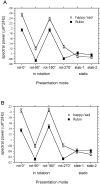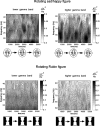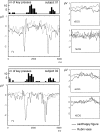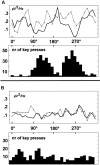Human gamma band activity and perception of a gestalt
- PMID: 10436068
- PMCID: PMC6782859
- DOI: 10.1523/JNEUROSCI.19-16-07152.1999
Human gamma band activity and perception of a gestalt
Abstract
Neuronal oscillations in the gamma band (above 30 Hz) have been proposed to be a possible mechanism for the visual representation of objects. The present study examined the topography of gamma band spectral power and event-related potentials in human EEG associated with perceptual switching effected by rotating ambiguous (bistable) figures. Eleven healthy human subjects were presented two rotating bistable figures: first, a face figure that allowed perception of a sad or happy face depending on orientation and therefore caused a perceptual switch at defined points in time when rotated, and, second, a modified version of the Rubin vase, allowing perception as a vase or two faces whereby the switch was orientation-independent. Nonrotating figures served as further control stimuli. EEG was recorded using a high-density array with 128 electrodes. We found a negative event-related potential associated with the switching of the sad-happy figure, which was most pronounced at central prefrontal sites. Gamma band activity (GBA) was enhanced at occipital electrode sites in the rotating bistable figures compared with the standing stimuli, being maximal at vertical stimulus orientations that allowed an easy recognition of the sad and happy face or the vase-faces, respectively. At anterior electrodes, GBA showed a complementary pattern, being maximal when stimuli were oriented horizontally. The findings support the notion that formation of a visual percept may involve oscillations in a distributed neuronal assembly.
Figures








References
-
- Attneave F. Multistability in perception. Sci Am. 1971;225:63–71. - PubMed
-
- Basar-Eroglu C, Struber D, Kruse P, Basar E, Stadler M. Frontal gamma-band enhancement during multistable visual perception. Int J Psychophysiol. 1996;24:113–125. - PubMed
-
- Bobes MA, Valdes-Sosa M, Olivares E. An ERP study of expectancy violation in face perception. Brain Cogn. 1994;26:1–22. - PubMed
-
- Cacioppo JT, Tassinary LG, Fridlund AJ. The skeletomotor system. In: Cacioppo JT, Tassinary JT, editors. Principles of psychophysiology: physical, social, and inferential elements. Cambridge UP; Cambridge, MA: 1990. pp. 325–384.
Publication types
MeSH terms
LinkOut - more resources
Full Text Sources
